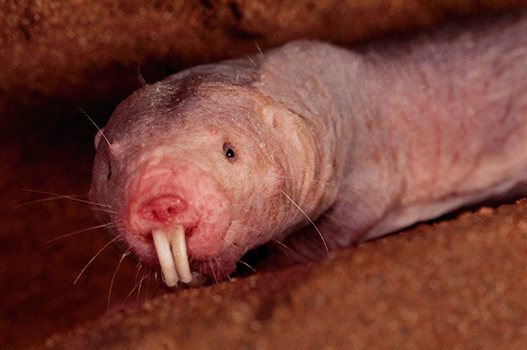Naked Mole-Rat Named “Vertebrate of the Year”
December 31, 2013
A tiny, pink, wrinkly-faced rodent with outsized yellow teeth and an underground lifestyle has been named Vertebrate of the Year by the journal Science. The magazine’s editors said they choose the naked mole-rat because of two recent groundbreaking studies that helped to explain why the rodent has such a long lifespan and why it seems to be resistant to cancer.
Native to East Africa, naked mole-rats live in well-organized colonies in large burrows with many rooms. The rodents dig their burrows using their short, strong limbs, large claws, strong jaws, and big front teeth. The lips of the naked mole-rat close behind their teeth, so they can dig without getting soil in their mouth.

The naked mole-rat is a burrowing rodent of East Africa with wrinkled pink skin and sharp, chisellike front teeth. Naked mole-rats live in large colonies of up to 300 members, engaging in social behavior similar to that of ants and honey bees. (© Frans Lanting Studio/Alamy Images)
Naked mole-rats are one of only two kinds of eusocial mammals. (The other is the Damaraland mole-rat of sub-Saharan Africa). The eusocial naked mole-rats, like ants and bees, live in highly organized colonies ruled by a queen. Only the queen and several male colonists breed. In fact, the queen bullies nonbreeding females and males to prevent them from reproducing. The nonbreeding members of the colony care for the young, maintain tunnels, find food, and attack predators. Smaller, younger workers do most of the maintenance work. Larger, older individuals work together to drive off snakes, as well as naked mole-rats from other colonies. Sometimes, these protectors sacrifice themselves for the sake of the colony.
Naked mole-rats have attracted the attention of a number of researchers for two reasons: the rodents age much more slowly than mice of the same size, and they seem to be immune to cancer. Two studies published in 2013 helped explain these remarkable characteristics. In June, researchers from the University of Rochester in New York reported that naked mole-rats produce a supersized version of a molecule that helps to make the rodents’ skin more elastic. When the researchers removed the molecule from the rodents’ cells, the cells started to clump together and form tumors. Then in October, some of the same researchers reported that naked mole-rat cells seem to be able to build new proteins without making many errors. Scientists think that such errors contribute to the aging process.
Additional information:
To learn more about the naked mole-rat from the Smithsonian Museum, see
http://nationalzoo.si.edu/animals/smallmammals/fact-nakedmolerat.cfm


